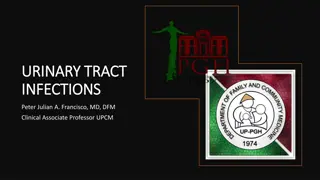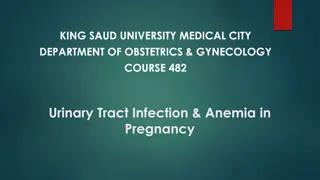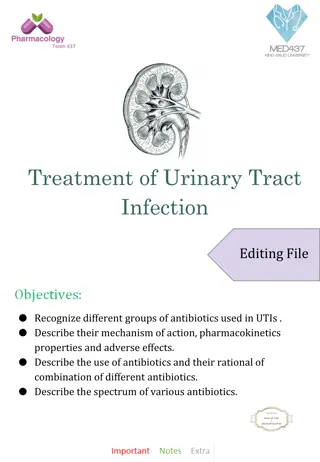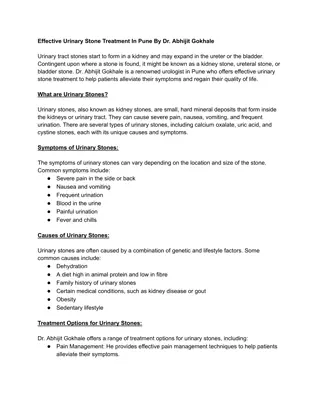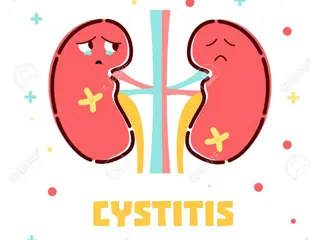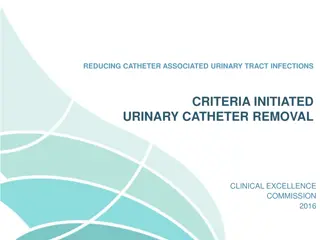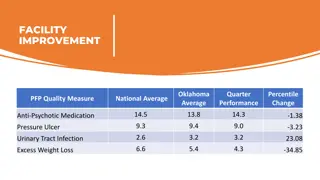Urinary Tract Infection Treatment and Prevention During Pregnancy
Effective management of urinary tract infections (UTIs) during pregnancy involves promoting urinary health, emphasizing safety of antimicrobial treatment, and understanding FDA categories for medication use. Recommendations include fluid intake, perineal hygiene, and maintaining bladder health. Safety precautions highlight the importance of choosing antibiotics based on teratogenicity and patient allergy. Specific antibiotics like nitrofurantoin and trimethoprim/sulfamethoxazole should be used cautiously during pregnancy, especially in the first trimester. Awareness of FDA medication categories and potential risks can guide appropriate UTI management in pregnant individuals.
Download Presentation

Please find below an Image/Link to download the presentation.
The content on the website is provided AS IS for your information and personal use only. It may not be sold, licensed, or shared on other websites without obtaining consent from the author.If you encounter any issues during the download, it is possible that the publisher has removed the file from their server.
You are allowed to download the files provided on this website for personal or commercial use, subject to the condition that they are used lawfully. All files are the property of their respective owners.
The content on the website is provided AS IS for your information and personal use only. It may not be sold, licensed, or shared on other websites without obtaining consent from the author.
E N D
Presentation Transcript
TREATMENT OF URINARY TRACT INFECTION DURING PREGNANCY D HIND SHOWMAN
HEALTH PROMOTION TO PREVENT UTI Fluid intake 2 2.5 L daily, more if hot weather or strenuous activity is involved Empty bladder every 3 4 hours Cleanse perineal area from front to back Void before and after sexual intercourse Maintain integrity of perineal tissues a. Avoid use of commercial feminine hygiene products or douches b. Wear cotton underwear Maintain acidity of urine (use of cranberry juice, take Vitamin C, avoid excess milk and milk products)
SAFETY OF ANTIMICROBIAL TREATMENT Nearly all antimicrobials cross the placenta, and some of them may exert teratogenic effects. So choose of antibiotic should be done according to it is teratogenicity, allergy of patient .
US FOOD AND DRUG ADMINISTRATION (FDA) CATEGORIES OF MEDICATIONS IN PREGNANCY Antibiotic FDA risk category Antibiotic FDA risk category Trimethoprim/sulfame thoxazol Amoxicillin B C Cephalosporins B Ciprofloxacin C Piperacillin/tazobacta m B Levofloxacin C Daptomycin B Imipenem/cilastatin C Azithromycin B Linezolid C Erythromycin B Clarithromycin C Meropenem B Spiramycin C Clindamycin B Gentamycin C Nitrofurantoin B Amikacin D Vankomycin iv. B Tobramycin D Metronidazol iv. B Netilmycin D Trimethoprim C Tetracyclines D
Nitrofurantoin and trimethoprim/sulfamethoxazole should be avoided during the first trimester due to a possible risk of fetal defects In the large American population-based National Birth Defects Prevention Study, maternal use of sulfonamides and nitrofurantoin (1 month before pregnancy to the end of the first trimester) was associated with more serious defects than any other antibacterial classes In the second and third trimester, trimethoprim/sulfamethoxazole and nitrofurantoin are well tolerated and by some considered even first line agents, except in the last week before delivery, when they may increase neonatal jaundice and predispose to kernicterus Nitrofurantoin has been used extensively and is considered safe to use during pregnancy, but not during delivery or when nearing term (i.e > 36 weeks). This is because of the possibility of haemolytic anaemia in the newborn, due to immature erythrocyte enzyme systems (glutathione instability All penicillins are considered safe to use during pregnancy, however, there is evidence that resistance to amoxicillin is higher than resistance to trimethoprim. For this reason, amoxiciilin is not suitable as an empiric therapy for acute cystitis but can be used if urine culture shows susceptibility
ASYMPTOMATIC BACTERIURIA IN PREGNANCY Treat all pregnant women with asymptomatic bacteriuria with antibiotics to prevent pyelonephritis . All pregnant women with ASB should have periodic screening after therapy, since as many as one third of them experience a recurrent infection There have been several trials which have shown that the following regimens are effective in the treatment of asymptomatic bacteriuria in pregnancy. Co-amoxiclav 625mg TDS for 5 days(Usta et al., 2011) or for 7 days (Estebanez et al., 2009) Cefuroxime axetil 250mg BD (Bayrak et al., 2007) or 500mg BD for 5 days(Usta et al., 2011) Cefaclor 500mg for 5-7 days for women with mild penicillin hypersensitivity (Stamatiou et al., 2007) Fosfomycin 3g stat dose (Estebanez et al., 2009, Bayrak et al., 2007, Usta et al., 2011, Zinner, 1990, Thoumsin et al., 1990). Second of these studies done in 2nd trimester only Nitrofurantoin 100mg BD PO for 7 days (Thoumsin et al., 1990)
ACUTE CYSTITIS The use of simple analgesia is appropriate to reduce the symptoms of suprapubic discomfort For treatment of symptomatic UTIs in pregnancy it is recommended to treat for seven days, except in the case where fosfomycin is used. A repeat urine culture should be sent a week after the antimicrobial treatment is finished to ensure that the bacteriuria has cleared.
Antibiotic dose Nitrofurantoin 100mg 12 hourly Cephalexin 500mg 12 hourly Amoxicillin/ clavulanate 500/125mg 12hourly Trimethoprim 300mg 24 hourly
TREATMENT OF PYELONEPHRITIS Should be more aggressive Admit to hospital some can be treated as an outpatient. Patients with pyelonephritis can become dehydrated because of nausea and vomiting and need IV hydration. However, they are at high risk for the development of pulmonary edema and acute respiratory distress syndrome (ARDS). regardless of whether they are hospitalized, antibiotics should be given parenterally, for at least the first 48 h (until the resolution of fever). Usually the treatment is initiated empirically and verified after obtaining the microbial sensitivity test results
Many women experience severe renal angle pain and analgesia is necessary. Simple analgesics usually suffice but opiates can be necessary in severe cases, or for concomitant renal colic. Nonsteroidal anti-inflammatory drugs (NSAIDs) should be avoided, as they are associated with fetal risks of 1-oligohydramnios and premature ductus arteriosus 2-closure and maternal risks of gastric mucosal 3-ulceration and reduced renal perfusion. Thromboprophylaxis should be used if the woman has reduced mobility or a period of bedrest. Tocolysis is frequently necessary. Antenatal steroids for fetal lung maturity.
Mild or moderate acute pyelonephritis Ceftriaxone 1 g every 24 h Cefepime 1 g every 24 h Amoxicillin with clavulanic acid 1.2 g every 12 h Aztreonam 1 g every 8 12 h Severe acute pyelonephritis/immunosuppres sion/urinary stasis Ticarcillin with clavulanic acid 3.1 g every 6 h Piperacillin with tazobactam 3.375 g every 6 h Meropenem 0.5 g every 8 h Ertapenem 1 g every 24 h Doripenem 1 g every 8 h
ANTIMICROBIAL PROPHYLAXIS FOR URINARY TRACT INFECTIONS IN PREGNANCY Antimicrobial prophylaxis should be considered also in women in the following groups * Pyelonephritis in this pregnancy * Known renal structural abnormality leading to urinary stasis *Recurrent urinary tract infections (Epp et al., 2010) The use of antimicrobial prophylaxis for recurrent UTIs or following pyelonephritis is a difficult area and there are not clear evidence based indications at present. Nitrofurantoin can be used for prophylaxis but should be avoided near term
The use of broad spectrum antimicrobials such as co-amoxiclav and cephalexin should be done following assessment of the benefits of prophylaxis against the risk of generating antimicrobial resistance in the patient leading to more limited treatment options at a later stage




